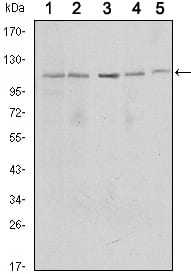
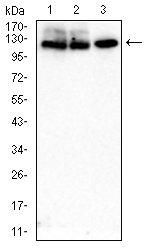
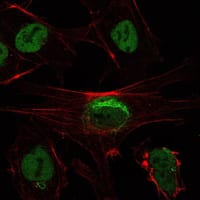
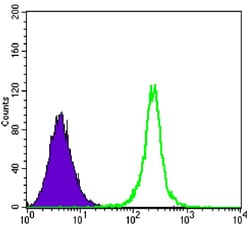
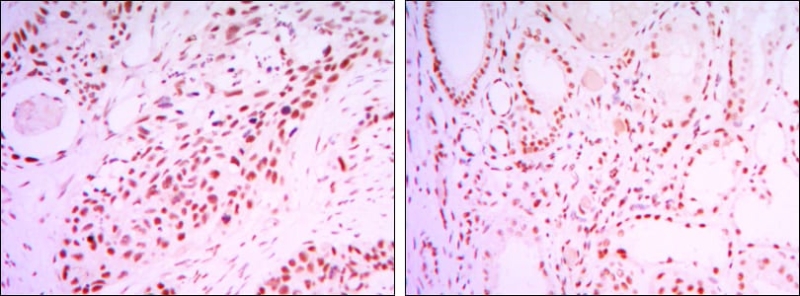
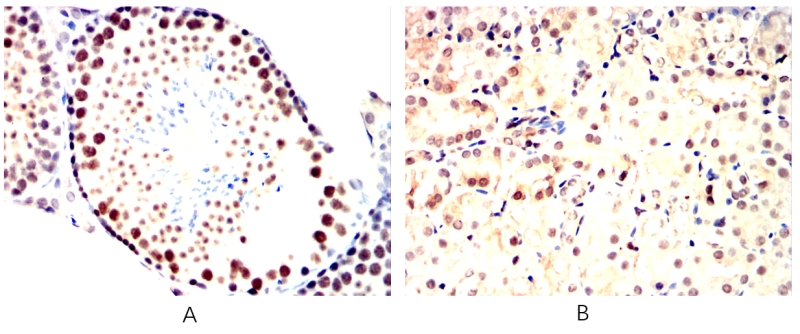
| WB | 1/500 - 1/2000 | Human,Mouse,Rat |
| IF | 咨询技术 | Human,Mouse,Rat |
| IHC | 1/200 - 1/1000 | Human,Mouse,Rat |
| ICC | 1/200 - 1/1000 | Human,Mouse,Rat |
| FCM | 1/200 - 1/400 | Human,Mouse,Rat |
| Elisa | 1/10000 | Human,Mouse,Rat |
| Aliases | SIR2L1; SIRT1 |
| Entrez GeneID | 23411 |
| clone | 1F3 |
| WB Predicted band size | 120kDa |
| Host/Isotype | Mouse IgG1 |
| Antibody Type | Primary antibody |
| Storage | Store at 4°C short term. Aliquot and store at -20°C long term. Avoid freeze/thaw cycles. |
| Species Reactivity | Human,Mouse,Rat,Rabbit,Monkey |
| Immunogen | Purified recombinant fragment of human SIRT1 expressed in E. Coli. |
| Formulation | Purified antibody in PBS with 0.05% sodium azide. |
+ +
以下是3篇关于SIRT1抗体的参考文献,包含文献名称、作者及摘要关键内容:
---
1. **文献名称**: *SIRT1 Deacetylase Protects Against Neurodegeneration in Models for Alzheimer’s Disease and Amyotrophic Lateral Sclerosis*
**作者**: Kim D, et al.
**摘要**: 本研究使用兔源多克隆SIRT1抗体(Cell Signaling Technology #2493)进行免疫印迹和免疫组化,验证了SIRT1在小鼠神经元中的表达及其在神经退行性疾病中的保护作用。抗体特异性通过SIRT1敲除小鼠脑组织验证。
---
2. **文献名称**: *Nutrient-Sensitive Mitochondrial NAD+ Levels Dictate Cell Survival*
**作者**: Yang T, et al.
**摘要**: 作者采用小鼠单克隆SIRT1抗体(Santa Cruz Biotechnology sc-74465)进行免疫沉淀和ChIP实验,揭示了SIRT1通过去乙酰化线粒体蛋白调控能量代谢。抗体验证包括siRNA敲降后的信号消失实验。
---
3. **文献名称**: *SIRT1 Regulates the Histone Methyl-Transferase SUV39H1 During Heterochromatin Formation*
**作者**: Vaquero A, et al.
**摘要**: 研究使用兔多克隆SIRT1抗体(Abcam ab12193)进行免疫荧光和Western blot,证实SIRT1与异染色质形成的关系。抗体的特异性通过肽段竞争实验验证,适用于哺乳动物细胞模型。
---
**备注**:以上文献均强调了SIRT1抗体的应用场景(如Western blot、免疫组化、ChIP)及严格的抗体验证方法(如基因敲除/敲降、肽段阻断),可作为实验选择的参考依据。
SIRT1 (silent mating type information regulation 2 homolog 1) is a NAD⁺-dependent deacetylase belonging to the sirtuin family, playing critical roles in aging, metabolism, stress response, and genomic stability. It regulates gene expression and cellular pathways by deacetylating histones (e.g., H3K9. H4K16) and non-histone targets like p53. FOXOs, and PGC-1α. Due to its involvement in age-related diseases, cancer, and metabolic disorders, SIRT1 has become a key focus in biomedical research.
SIRT1 antibodies are essential tools for detecting SIRT1 expression, localization, and activity in cells or tissues. They are widely used in techniques such as Western blotting, immunohistochemistry (IHC), immunofluorescence (IF), and chromatin immunoprecipitation (ChIP). Polyclonal antibodies typically recognize multiple epitopes, offering high sensitivity, while monoclonal antibodies provide specificity for single epitopes. Validation is crucial, as SIRT1 exists in multiple isoforms and post-translational modifications (e.g., phosphorylation) may affect antibody binding. High-quality antibodies are validated using knockout controls or siRNA-mediated knockdown to confirm target specificity.
Research applications include studying SIRT1's roles in caloric restriction, oxidative stress, inflammation, and neurodegenerative diseases (e.g., Alzheimer’s). Commercial antibodies often specify reactivity across species (human, mouse, rat) and provide application-specific recommendations. Proper controls and optimization are necessary to avoid cross-reactivity with other sirtuins (SIRT2-7) or nonspecific signals.
×